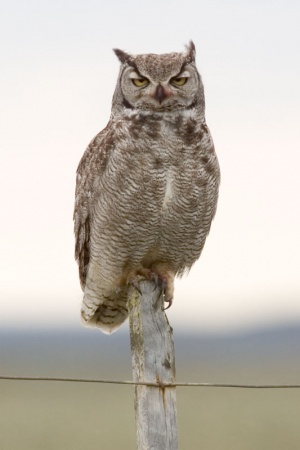(Dictionary link) |
|||
| Line 53: | Line 53: | ||
Great Horns are largely nocturnal, but will hunt in daylight if necessary. They are mainly perch hunters, sitting atop a favored vantage point (often at the edge of the forest) and scanning for prey. | Great Horns are largely nocturnal, but will hunt in daylight if necessary. They are mainly perch hunters, sitting atop a favored vantage point (often at the edge of the forest) and scanning for prey. | ||
====Breeding==== | ====Breeding==== | ||
| − | + | Normally a stick nest in a tree built by some other species (like all owls they don't build their own nests). The young are cared for by both adults. | |
| + | |||
====Vocalisation==== | ====Vocalisation==== | ||
Most subspecies give a loud, booming hoot; ''hoo hu-hoo, hoo hoo''. | Most subspecies give a loud, booming hoot; ''hoo hu-hoo, hoo hoo''. | ||
Revision as of 15:50, 2 May 2016
- Bubo virginianus
Includes Magellanic Horned Owl
Identification
L. 18-23 in (45¾-58½ in)
Ws. over 4 ft
The quintessential owl
- Two tufts of feathers on either side of head
- Cat-like head shape
- Mostly brownish with patterning
- Northern birds are very pale
- Birds in Pacific Northwest are almost black
- Rust orange face
- White throat
- Buff below
- Pale, lightly feathered feet
- Gleaming golden eyes (amber in subspecies B.v. nacurutu).
- Powerful talons
Distribution
A very widely distributed bird throughout the Americas. Great Horns are found from Alaska to Chile and Argentina, mainly in forested areas; they also live in desert regions, where they nest in cacti.
Published range maps do not include the Amazon Basin in South America; however, at least one Birdforum member has found a bird in an area north of the Amazon River in Brazil.
These birds are largely sedentary, though northern birds may irrupt, and there may be seasonal movement within territories.
Taxonomy
Subspecies
Thirteen subspecies are recognized[1] with some authors recognizing even more:
- B.v. lagophonus - Central Alaska to north-eastern Oregon and Montana; winters to Texas
- B.v. saturatus - Coastal south-western Alaska (Cook Inlet) to coastal central California
- B.v. pacificus - Coastal California to nw Baja California
- B.v. elachistus - Southern Baja California and Isla Espirito Santo
- B.v. subarcticus (occidentalis) - Mackenzie and north-western British Columbia to Hudson Bay, Wyoming, North Dakota
- B.v. pallescens - deserts of central and south-eastern California to Kansas and southern Mexico (Oaxaca)
- B.v. heterocnemis - North-eastern Canada south to Great Lakes region
- B.v. virginianus - Minnesota east to the Atlantic and south to Texas and Florida
- B.v. mayensis - Yucatan peninsula
- B.v. mesembrinus - most of Central America
- B.v. nigrescens - Colombia to Ecuador and Peru
- B.v. nacurutu - South America east of the Andes south to Argentina
- B.v. magellanicus - western South America from Peru to the south tip including most of Chile
The last unit is sometimes considered a full species Magellanic Horned Owl Bubo magellanicus which shows narrow barring on the underparts. It occurs in three color morphs, pale, dark, with some intermediate birds, and their main differences from regular Great Horned Owl are smaller size and voice.
Habitat
Varied habitats in its breeding range, from forest to city to open desert. Forest habitats, range from scrub through open woods to dense forests.
Behaviour
A fierce predator, known as the "Winged Tiger" or "Flying Tiger".
Diet
Will hunt small rodents, rabbits and hares, snakes, other birds (particularly waterfowl), and many other small animals. They have been known to pluck hawks and falcons from their nightly roosts, and they are some of the only animals which can hunt porcupines and skunks.
Great Horns are largely nocturnal, but will hunt in daylight if necessary. They are mainly perch hunters, sitting atop a favored vantage point (often at the edge of the forest) and scanning for prey.
Breeding
Normally a stick nest in a tree built by some other species (like all owls they don't build their own nests). The young are cared for by both adults.
Vocalisation
Most subspecies give a loud, booming hoot; hoo hu-hoo, hoo hoo.
The Magellan form has a three syllable call "hoo - hoo - hrrrrrrrrrrr", the last part downslurred, purring, and difficult to hear from a distance as it is much less strong.
References
- Clements, J. F., T. S. Schulenberg, M. J. Iliff, D. Roberson, T. A. Fredericks, B. L. Sullivan, and C. L. Wood. 2015. The eBird/Clements checklist of birds of the world: v2015, with updates to August 2015. Downloaded from http://www.birds.cornell.edu/clementschecklist/download/
- Alvaro Jaramillo. 2003. Birds of Chile. Princeton Field Guides. ISBN 0-691-11740-3
- BF Member observations
Recommended Citation
- BirdForum Opus contributors. (2024) Great Horned Owl. In: BirdForum, the forum for wild birds and birding. Retrieved 16 June 2024 from https://www.birdforum.net/opus/Great_Horned_Owl
External Links







